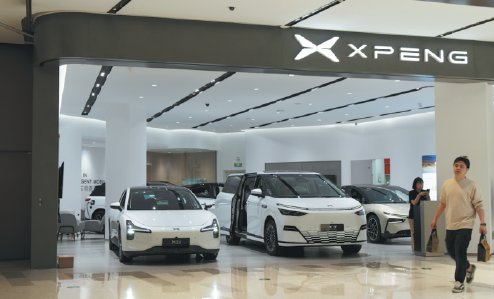Offseason can't halt China carmakers' rise
Domestic new energy vehicle manufacturers report strong first-quarter sales performance


Chinese automotive companies reported robust market performance amid the first-quarter offseason and intense competition, showcasing their ability to sustain growth through new energy vehicles, overseas market penetration and operational efficiency.
BYD led the pack with Q1 operating income reaching 170.3 billion yuan ($23.64 billion), a 36.35 percent increase year-on-year, and a net profit of 9.16 billion yuan, soaring 100.38 percent compared with the same period of 2024.
The rapid increase in sales volume was a key factor driving BYD's performance, which reached 1.01 million NEVs in Q1, up 59.81 percent year-on-year.
Among them, its overseas sales jumped 110.51 percent to 206,100 units during the period, accounting for 20.59 percent of total sales.
Overseas markets have become a crucial engine of sales growth for the company. In 2025, BYD aims to sell 5.5 million vehicles, with an overseas target of 800,000 vehicles.
In mid-May, BYD unveiled its European headquarters in Hungary. It will oversee key functions like sales, after-sales services, vehicle certification, testing and local design.
"The establishment of BYD's European headquarters signifies a deep integration between BYD and Hungary's local automotive industry, reaffirming BYD's strong commitment to long-term development in Europe," said Wang Chuanfu, chairman of BYD.
Meanwhile, Geely posted strong growth momentum. In the first quarter, Geely Auto's revenue hit 72.5 billion yuan, up 25 percent year-on-year, and its net profit surged by 264 percent to 5.67 billion yuan.
Its Q1 sales reached 704,000 units, up 48 percent, having achieved 26 percent of its sales target for 2025.Sales of NEVs, including Geely-branded, Lynk & Co and Zeekr, reached 339,000 units in the first quarter, accounting for more than half of its total sales.
In a move toward deeper integration, Geely announced plans to acquire all outstanding shares of Zeekr earlier this month, aiming to consolidate resources across R&D, manufacturing and sales.
The startups also demonstrated improved financial health, with notable progress in delivery volumes and cost management.
XPeng's financial report released on Wednesday shows its Q1 revenue reached 15.81 billion yuan, jumping 141.5 percent year-on-year.
Thanks to strengthened cost controls, XPeng's automotive gross profit margin increased to 10.5 percent, up 5 percentage points compared to the same period of 2024, and it achieved growth for seven consecutive quarters.
Its Q1 deliveries reached 94,008 units, skyrocketing 331 percent year-on-year and taking the lead among NEV startups. It has had more than 30,000 monthly deliveries for five straight months.
CEO He Xiaopeng said: "Despite the industry's offseason, we achieved a historic quarterly delivery high, making XPeng the top-selling startup.
"Our growth potential is just beginning to be unleashed. Upcoming new models, international expansion and accelerated AI-driven technology will fuel sustained growth," he said.
The company is expected to deliver 102,000 to 108,000 vehicles in the second quarter and achieve profitability in the fourth quarter this year.
Another sought-after NEV startup, Leapmotor, also achieved significant revenue growth and margin improvement.
Its financial report shows that Q1 revenue was 10.02 billion yuan, a year-on-year increase of 187.1 percent with a net loss of 130 million yuan, significantly narrowed from a net loss of 1.01 billion yuan in the same period of 2024.
It hit a record high gross profit margin of 14.9 percent in the first quarter, an improvement from 1.4 percent in the same period of 2024.
Leapmotor delivered 87,552 vehicles in the first quarter, representing a 162 percent year-on-year increase.
Li Tengfei, vice-president of Leapmotor, said that it aims for sales of 500,000 to 600,000 vehicles with a 10 to 12 percent gross profit margin to achieve break-even this year.
In autonomous driving, Pony.ai reported Q1 revenue rose 12 percent year-on-year to $14 million, underpinned by a 200 percent increase in robotaxi service volume and an eightfold jump in fare-charging revenue.
The company said the strong growth rate was primarily attributable to the expansion of its public-facing fare-charging operations in tier-one cities in China and refined operational strategies for diverse user groups.
Peng Jun, co-founder and CEO of the company, said that 2025 is the year of scaling up for Pony.ai. With the cost reduction of the seventh-generation robotaxi autonomous driving system and an accelerated production pace, it expects its robotaxi fleet to expand to 1,000 vehicles by the year's end.
Its peer WeRide generated revenue of 72.44 million yuan in the first quarter with a gross profit margin of 35 percent, according to financial reports released on Wednesday. Notably, robotaxi revenue amounted to 16.1 million yuan, marking a substantial increase in its share of total revenue to 22.3 percent.
WeRide deepened strategic cooperation with Uber earlier in May, receiving a $100 million investment. The two sides plan to expand robotaxi services to 15 cities globally over the next five years, covering markets in Europe and the Middle East. WeRide currently operates more than 1,200 autonomous vehicles on public roads.




































